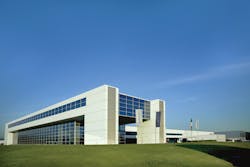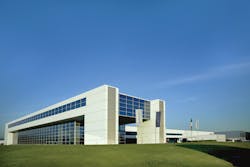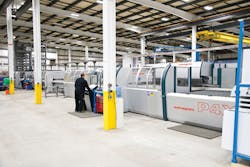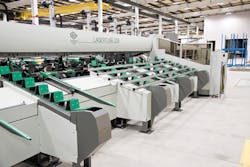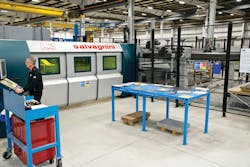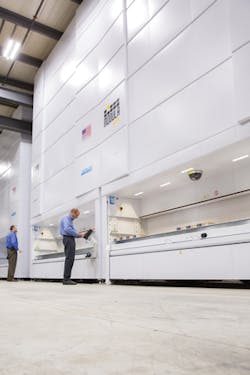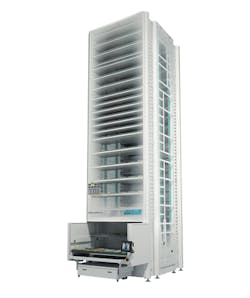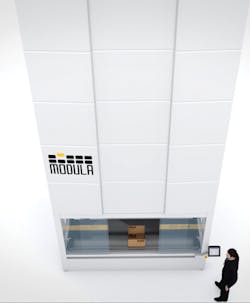Laser cutting for storage systems
Manufacturing process yields high precision
FRANCESCA CUOGHI
Modula is part of the System Group (Fiorano Modenese, Italy; FIGURE 1), and it is focused on vertical lift storage systems. The company designs and implements manufacturing process solutions for the ceramic industry and other industrial sectors, such as packaging, electronics, and intralogistics, with a multidisciplinary approach embracing precision mechanics, electronics, information technology, physics, and chemistry. The Group is active in 25 countries via 37 subsidiaries, and has a turnover of €440 million (over $491 million) with over 1700 employees worldwide.
Modula manufactures automated picking and storage solutions designed to optimize space, as well as improve picking and storage operations. They employ 250 people in facilities in Italy (Salvaterra di Casalgrande, Reggio Emilia) and the US. In addition, there are 13 branch offices in Europe, the Americas, Asia, and Africa that are supported by a wide network of 45 authorized dealers.
At the newest US facility located in Lewiston, ME (FIGURE 2), Modula invested over $8 million in new manufacturing automation and upgrades to the facilities in 2015. The decision is in alignment with the evolving needs of US buyers who favor the lead time and support offered by providers with homegrown manufacturing capabilities. Currently, the company produces a full range of products in the US, and offers fast delivery.
Modula's US manufacturing plant is equipped with the latest in automation, from laser cutting (FIGURE 3) and welding to automated punches, brakes, and presses. The company's advanced technology guarantees optimal quality, relying on partners such as Salvagnini (Cincinnati, OH) and Comau (Southfield, MI) to create cutting-edge automated vertical storage solutions that are designed to recover floor space and increase productivity by speeding picking operations, thus increasing efficiency in the warehouse.
The 102,000-sq-ft. Lewiston facility is equipped with an inline automated job shop (AJS) system from Salvagnini to guarantee plant speed, flexibility, and lights-out capabilities, from sheet loading to finished components. The option of whether to produce a single-piece flow, kits, or batches depends on the specific orders. The software is implemented to integrate and control machinery and material handling systems, and communicates with material requirements planning (MRP) and enterprise resource planning (ERP) systems to create programs and manage the production flow. Production processes are integrated, lean, and flexible.
The AJS system includes a punching and shearing center with storage tower, a panel bender, a fiber laser, and a press brake. Each piece of equipment has introduced new technology and automation advantages on the Modula shop floor. By connecting the manufacturing equipment via robotic systems and software, costs are reduced while productivity is increased.
Highly digitalized facility
The capacity to hold between 76 and 96 active punches on the stationary punching head eliminates the time required to grab and change tooling, leading to a reduction in cycle times. A shear is positioned alongside the punching head. The incorporated punching/shearing center implements an automated storage and retrieval system, as well as tower and inline automatic destackers used to load materials and send punched/sheared forms downstream.
The system automatically routes parts from the punch/shear combination or blanks from a Salvagnini L3 fiber laser (FIGURE 4) to a panel bender or a hybrid press brake for forming. Sheets are bent into drawers or other components by means of universal tooling and Automated Bending Technology (ABT) on the panel bender. Precision of the lights-out operation is guaranteed by automatic part centering with automatic compensation for different materials or thicknesses, deflection, or material changes because of environmental factors. The press brake is used to create larger pieces.
The Salvagnini fiber laser cuts parts from a range of materials that mainly comprise stainless steel, in thicknesses up to 3⁄4 in. The controller incorporates a series of functions that combine application requirements with generated trajectories to calculate and predetermine cutting directions, speeds, and accelerations.
The drawings of the parts go directly to the machines involved and everything happens in an automated manner. There are some machines that can operate unsupervised for more than a shift and this can smooth out production flow. The 25 processing units include specific models for the pharmaceutical, healthcare, military, automotive, and energy sectors. Flexibility in the production process here is really a must, given the sizes, types, and quantities of components going into the units.
Modula's automated technologies are designed and built around the concept of simplicity and efficiency when operating in harsh industrial environments. The products are fully equipped with a touchscreen graphical user interface with color display and intuitive icons, making the learning process straightforward for new operators.
The vertical lift solutions from Modula (FIGURE 5) are also characterized by an internal bay that is an ideal solution when companies need to keep floor space to a minimum, while the external bay offers an excellent ergonomic work environment for the operators picking heavy-load goods. The internal and external bay can be utilized, depending on how often the machines will be used. This dual-bay configuration allows for high productivity, reducing the idle time when the operator is picking the next tray. The next tray can reach the operator a few seconds after the prior operation was completed, making the rotations continuous. The company's automated retrieval system offers intuitive function and seamless transactions (FIGURE 6).
Innovation never stops
The Modula OnePick system combines the vertical lift module's technology with an automated system for picking or replenishment of a single product (FIGURE 7) directly from the bay, reducing the error margin to zero and guaranteeing a high level of safety. Products can be picked and replenished in a fully automated way in combination with delivery and a takeaway conveyor, via the introduction of an innovative secure delivery interface window, which guarantees greater accuracy and precision.
At the operator's request, OnePick retrieves the selected item and places it in a retrieval location in the secure delivery window. The unit's design ensures that when the door opens automatically, the operator has access to that requested item. With this feature, inventory is always safe and under control, making the storage-solution system suitable for valuable items that need flawless and safe picking.
This added customization grants users the option of switching operation modes from standard Vertical Lift with access to SKUs from a full tray, to a restricted-access, single-pick device. The versatile nature of OnePick makes it the only machine in the market that features the flexibility of being integrated into a fully automated line and at the same time serving alongside human operators.
Fully automated manufacturing facilities and state-of-the-art technology are at the forefront of the next-generation vertical lift solutions engineered and developed by Modula. "We use laser cutting in our facility because this manufacturing process can reach very high precision compared to the traditional production method. It also enables us to cut complex shapes without the need for tooling, and it is able to produce complex, detailed parts," says Miguel Fabra, Modula's CEO.
FRANCESCA CUOGHI ([email protected]) is the press office supervisor for System Group, Fiorano Modenese, Italy; www.system-group.it.
